- Home
- About
- Map
- Trips
- Bringing Boat West
- Migration West
- Solo Motorcycle Ride
- Final Family XC Trip
- Colorado Rockies
- Graduates' XC Trip
- Yosemite & Nevada
- Colorado & Utah
- Best of Utah
- Southern Loop
- Pacific Northwest
- Northern Loop
- Los Angeles to NYC
- East Coast Trips
- Martha's Vineyard
- 1 Week in Quebec
- Southeast Coast
- NH Backpacking
- Martha's Vineyard
- Canadian Maritimes
- Ocracoke Island
- Edisto Island
- First Landing '02
- Hunting Island '02
- Stowe in Winter
- Hunting Island '01
- Lake Placid
- Chesapeake
- Provincetown
- Hunting Island '00
- Acadia in Winter
- Boston Suburbs
- Niagara Falls
- First Landing '99
- Cape Hatteras
- West Coast Trips
- Burning Man
- Utah Off-Roading
- Maui
- Mojave 4WD Course
- Colorado River Rafting
- Bishop & Death Valley
- Kauai
- Yosemite Fall
- Utah Off-Road
- Lost Coast
- Yosemite Valley
- Arizona and New Mexico
- Pescadero & Capitola
- Bishop & Death Valley
- San Diego, Anza Borrego, Joshua Tree
- Carmel
- Death Valley in Fall
- Yosemite in the Fall
- Pacific Northwest
- Utah Off-Roading
- Southern CA Deserts
- Yosemite & Covid
- Lake Powell Covid
- Eastern Sierra & Covid
- Bishop & Death Valley
- Central & SE Oregon
- Mojave Road
- Eastern Sierra
- Trinity Alps
- Tuolumne Meadows
- Lake Powell Boating
- Eastern Sierra
- Yosemite Winter
- Hawaii
- 4WD Eastern Sierra
- 4WD Death Valley +
- Southern CA Deserts
- Christmas in Tahoe
- Yosemite & Pinnacles
- Totality
- Yosemite & Sierra
- Yosemite Christmas
- Yosemite, San Diego
- Yosemite & North CA
- Seattle to Sierra
- Southwest Deserts
- Yosemite & Sierra
- Pacific Northwest
- Yosemite & South CA
- Pacific Northwest
- Northern California
- Southern Alaska
- Vancouver Island
- International Trips
- Index
- Tips
- Books
- Photos/Videos
- Search
- Contact
Little Wild Horse Slot Canyon
Monday, September 11, 2023 - 10:15am by Lolo20 miles and 0.5 hours from our last stop
Travelogue
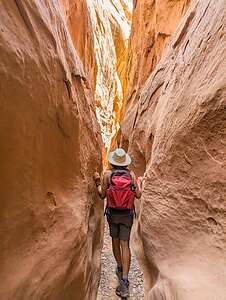 Little Wild Horse Slot CanyonWhen we arrived at the Goblin Valley Visitor Center we looked at the weather forecast and saw the possibility of thunderstorms tomorrow, but no threat of rain today. Hmmm…That might change our plans a bit.
Little Wild Horse Slot CanyonWhen we arrived at the Goblin Valley Visitor Center we looked at the weather forecast and saw the possibility of thunderstorms tomorrow, but no threat of rain today. Hmmm…That might change our plans a bit.
Knowing that a slot canyon was not a good place to be in a thunderstorm, we immediately switched our plans from hiking Little Wild Horse Slot Canyon from tomorrow to today - in fact, pretty much to right now.
We really didn’t want to miss out on this hike, as it is the most popular in the entire San Rafael Swell, and that’s saying a lot.
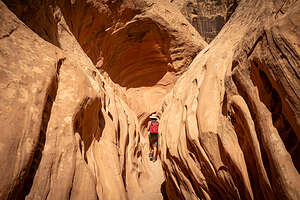 Little Wild Horse Slot CanyonNormally, I wouldn’t want to start a desert hike at high noon, but a little light in a slot canyon isn’t necessarily a bad thing. Plus, we would probably find lots of shade as well.
Little Wild Horse Slot CanyonNormally, I wouldn’t want to start a desert hike at high noon, but a little light in a slot canyon isn’t necessarily a bad thing. Plus, we would probably find lots of shade as well.
Little Wild Horse Canyon is not officially part of Goblin Valley State Park, but the dirt road to the trailhead is right by the Park entrance. So, rather than even enter Goblin Valley now, we drove the 5 miles down the Little Wild Horse Canyon dirt road to the trailhead. There were several cars in the parking lot, but most people were exiting the canyon, as they had started their hike in the morning, as we normally would.
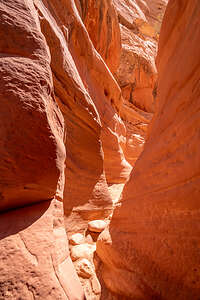 Little Wild Horse Slot CanyonAfter parking our car, we took the trail leading to the dry wash bed and followed it for a few hundred yards. After about 10 minutes, the riverbed narrowed and we came to a dry waterfall, which we got around by ascending an inclined plane to the left of it.
Little Wild Horse Slot CanyonAfter parking our car, we took the trail leading to the dry wash bed and followed it for a few hundred yards. After about 10 minutes, the riverbed narrowed and we came to a dry waterfall, which we got around by ascending an inclined plane to the left of it.
Continuing along the wash, I almost missed the right turn at the fork into Little Wild Horse Canyon. In fact, I didn’t even see the fork, until Herb called me back. It’s easy to miss because the entrance is a concealed slit at the right side of the canyon. There is a sign though.
The other way went to Bell Canyon. You can do an 8-mile loop around both Little Wild Horse and Bell Canyons, but that wasn’t our plan for today. We still had lots to do in Goblin Valley.
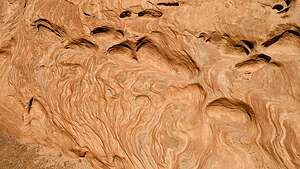 Textured walls of Little Wild Horse Slot CanyonA few hundred yards further, things got really interesting, both in terms of color and texture of the rock walls. The soft light reflecting off the canyon walls painted the rocks a vibrant red, and interesting holes, niches, and swirls were carved out by millions of years of water action on the walls. It was stunning.
Textured walls of Little Wild Horse Slot CanyonA few hundred yards further, things got really interesting, both in terms of color and texture of the rock walls. The soft light reflecting off the canyon walls painted the rocks a vibrant red, and interesting holes, niches, and swirls were carved out by millions of years of water action on the walls. It was stunning.
After about a mile and a half, we came to a very narrow and wet section, which would have required us getting our boots wet, so we turned around and went back from whence we came.
The hike was a little over 3-miles with very little elevation gain.
San Rafael Swell
Monday, September 11, 2023 - 9:30am by Lolo200 miles and 4 hours from our last stop
Travelogue
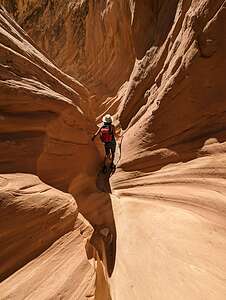 Little Wild Horse Slot CanyonWhen Herb dreamed up this spur of the moment Utah trip, all he could talk about was wanting to see Factory Butte. In fact, before I got involved, that was his entire itinerary.
Little Wild Horse Slot CanyonWhen Herb dreamed up this spur of the moment Utah trip, all he could talk about was wanting to see Factory Butte. In fact, before I got involved, that was his entire itinerary.
However, there’s a lot more cool stuff to see in the San Rafael Swell area besides Factory Butte, like the Little Wild Horse Canyon, Goblin Valley, the Mars Desert Research Station, Long Dong Silver, and the Moonscape Overlook. I will provide more detail on each of these in the following stops.
The San Rafael Swell is an oval-shaped uplifted area of layered rocks (anticlines) in south-central Utah that covers about 75 by 40 miles.
.thumbnail.jpg) Bentonite HillsIt is characterized by mesas, cliffs, buttes, magnificent badlands of brightly colored and wildly eroded sandstone formations, and canyons.
Bentonite HillsIt is characterized by mesas, cliffs, buttes, magnificent badlands of brightly colored and wildly eroded sandstone formations, and canyons.
I-70 cuts right through it and divides the swell into northern and southern sections, and provides the only interstate access to the region. The only town of any significant size in The Swell is Green River, located on I70. We would be exploring the southern section.
With the exception of that, it is one of the emptiest and least developed regions in Utah and one of the last great wilderness areas of the Southwest without National Park or Monument status.
 Moonscape OverlookSo for now at least, few people are aware of its stunning beauty and recreational opportunities. That plus its confusing network of dirt roads will hopefully keep it undiscovered for a while longer.
Moonscape OverlookSo for now at least, few people are aware of its stunning beauty and recreational opportunities. That plus its confusing network of dirt roads will hopefully keep it undiscovered for a while longer.
It is mostly owned by the BLM, which Herb loves, because that means it is open to all and access is unrestricted, meaning we could pretty much camp anywhere.
The nearest town with any services is Hanksville (population 162) at the junction of Utah 24 and Utah 95. Its location is very convenient to a lot of cool places and serves as a great base camp for exploring this section of the southern section of the San Rafael Swell.
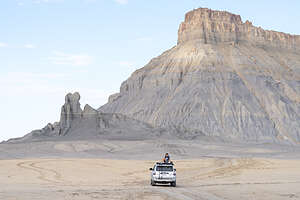 Factory ButteThere are 3 hotels in the town and 3 restaurants, the most popular being Duke’s Slickrock Grill. We actually had eaten here the last time we passed through here.
Factory ButteThere are 3 hotels in the town and 3 restaurants, the most popular being Duke’s Slickrock Grill. We actually had eaten here the last time we passed through here.
It is named after John Wayne, and the place is full of memorabilia about the Duke. Herb even posed with a Duke cutout at the bar.
The restaurant is really good and serves very large portions - a bit too slanted to meat over vegetables though for my taste. Still, it was pretty much the only game in town, so we ate there for lunch before heading out to explore the San Rafael Swell area northwest of Hanksville.
Delta
Sunday, September 10, 2023 - 8:15pm by Lolo96 miles and 1.5 hours from our last stop - 1 night stay
Travelogue
 Herb sad that he missed Burning ManWe didn’t want to drive too much further today, as it was already after 2:00 pm, so we set our sights on the little town of Delta about an hour and a half more on US 50 into Utah. Although US 50 in Utah is no longer referred to as the “Loneliest Road,” it was still pretty lonely. There was nothing in between Great Basin and Delta.
Herb sad that he missed Burning ManWe didn’t want to drive too much further today, as it was already after 2:00 pm, so we set our sights on the little town of Delta about an hour and a half more on US 50 into Utah. Although US 50 in Utah is no longer referred to as the “Loneliest Road,” it was still pretty lonely. There was nothing in between Great Basin and Delta.
Actually, I take that back. Herb managed to find an empty playa (dried up Sevier Lake) and got off US 50 to take a dirt road down to it. He was tempted to drive out onto it, but it was a little muddy mushy from the recent rains, and I didn’t want to do what happened to vehicles a few weeks back at Burning Man.
 Sevier PlayaInstead, he satisfied himself with walking out onto it. I kidded that this might be a way for him to work out his grief over missing Burning Man. He was not amused.
Sevier PlayaInstead, he satisfied himself with walking out onto it. I kidded that this might be a way for him to work out his grief over missing Burning Man. He was not amused.
I enjoy a good playa as well, so I joined him.
As we entered the town of Delta, Utah, we began looking for a place to stay. I yelled to Herb to turn the car around and drive back a short distance. I told him I found the perfect place. He was also not amused when I pointed at the Delta Schitt’s Creek motel. Hahahaha
 HahahahaStaying there would have been worth it, just to tell the kids.
HahahahaStaying there would have been worth it, just to tell the kids.
Instead, we stayed at a Days Inn Wyndham, which was pretty nice. Plus, it was a short walk from our hotel to Taco Shop El Jalisciense, where I had a really good quesadilla.
From Delta, it was just a little over 3 hours to Goblin Valley. Perfect!
Great Basin National Park
Sunday, September 10, 2023 - 11:15am by Lolo156 miles and 3 hours from our last stop
Travelogue
 Reverse tree huggerAfter spending a short time photographing the Eureka Main Street, we continued east on “The Loneliest Road,” eventually passing through the town of Ely, Nevada (mile 320). With a population of 4,002, it was significantly larger than Eureka.
Reverse tree huggerAfter spending a short time photographing the Eureka Main Street, we continued east on “The Loneliest Road,” eventually passing through the town of Ely, Nevada (mile 320). With a population of 4,002, it was significantly larger than Eureka.
 Bristlecone PineEly is the site of Nevada’s largest and longest-lived mining ventures, but they mined for copper, not silver or gold. At its peak during the 1950s, Ely produced over a billion dollars worth of copper ore and employed over 10,000 people. After the mines closed down in 1982, the town went bust and the railroad depot was turned into the Nevada Northern Railway Museum. However, it is still one of the larger towns on the Loneliest Road and home to the only supermarket in 250 miles.
Bristlecone PineEly is the site of Nevada’s largest and longest-lived mining ventures, but they mined for copper, not silver or gold. At its peak during the 1950s, Ely produced over a billion dollars worth of copper ore and employed over 10,000 people. After the mines closed down in 1982, the town went bust and the railroad depot was turned into the Nevada Northern Railway Museum. However, it is still one of the larger towns on the Loneliest Road and home to the only supermarket in 250 miles.
East of Ely, US-50 continues another 25 miles before ascending 7,722-foot Connors Pass. From the summit, 13,061-foot Wheeler Peak comes into view.
In another 20 miles is the town of Baker and the turnoff for Great Basin National Park, Nevada’s only national park. It’s also one of the smallest parks in the national park system, and its remote location near the Nevada-Utah border also makes it one of the least visited.
 Wheeler Peak comes into viewWe were now 382 miles from Reno, almost done with the 400 miles through Nevada on the Loneliest Road.
Wheeler Peak comes into viewWe were now 382 miles from Reno, almost done with the 400 miles through Nevada on the Loneliest Road.
Despite Great Basin’s small size, it boasts a treasure trove of riches, including:
- the only glacier in Nevada
- 13,063-foot Wheeler Peak, the second highest mountain in the state
- a large forest of 3,000- to 4,000-year-old bristle-cone pines, the oldest living creatures on the planet
- groves of white-barked aspen
- the extensive and fascinating Lehman Caves.
The last time we were here back in 2007, we only visited the Lehman Caves, because we were not allowed to drive up to Wheeler Peak in our Lazy Daze motorhome, (no vehicles over 20 feet allowed). The Wheeler Peak Road is about 12 miles one way and climbs 3,400 feet in elevation as it winds its way up the Snake Mountain Range. Not appropriate for a motorhome.
.thumbnail.jpg) Rock GlacierIt was, however, very appropriate for our Toyota 4Runner, so up we went to Wheeler Peak, where we would start our Bristlecone and Glacier hike. Pretty cool that in one hike we would be able to walk amongst the oldest living species on Earth, and see Nevada’s only remaining glacier (before it melts away).
Rock GlacierIt was, however, very appropriate for our Toyota 4Runner, so up we went to Wheeler Peak, where we would start our Bristlecone and Glacier hike. Pretty cool that in one hike we would be able to walk amongst the oldest living species on Earth, and see Nevada’s only remaining glacier (before it melts away).
We headed out on the Bristlecone Glacier trail and in about a mile came to a grove of Bristlecone Pines, which are the world’s oldest living species, the longest having lived almost 5,000 years.
They are very photogenic, each of them individually sculpted by thousands of years of wind, ice, and extreme exposure to the elements. Their twisted and contorted shapes are evidence of their ability to not only survive, but to thrive in adverse living conditions. It’s funny how the harshest growing conditions produce trees that live the longest and are the most contorted and interesting. There’s much to be said for tough love.
.thumbnail.jpg) Out on the iceOne thing I did not though was that the bristlecones here looked much less healthy than the ones we had recently visited in the Ancient Bristlecone Pine Forest in Big Pine, California. Many of the ones in Great Basin were dead - you can tell by the fact that they are gray rather than having that rich brownish chocolate coloring. Not sure why that might be. Maybe it has something to do with climate change and the differing attitudes and environments of the different groves.
Out on the iceOne thing I did not though was that the bristlecones here looked much less healthy than the ones we had recently visited in the Ancient Bristlecone Pine Forest in Big Pine, California. Many of the ones in Great Basin were dead - you can tell by the fact that they are gray rather than having that rich brownish chocolate coloring. Not sure why that might be. Maybe it has something to do with climate change and the differing attitudes and environments of the different groves.
Once past the Bristlecone Pine Grove, the woods became more sparse and we got our first clear views of Wheeler Peak Glacier, which sits at the base of Wheeler Peak, in a protected cirque around 11,500 feet in elevation.
As we proceeded up onto the glacier moraine, the trail became much rockier and unstable, as we transitioned into alpine territory.
.thumbnail.jpg) Out on the iceUnlike the ice glaciers we had seen on our recent trip to Iceland, the Wheeler Peak Glacier is a rock glacier, meaning that the ice visible on the surface is only a portion of the whole glacier, the rest is covered with debris and therefore considered to be a rock glacier.
Out on the iceUnlike the ice glaciers we had seen on our recent trip to Iceland, the Wheeler Peak Glacier is a rock glacier, meaning that the ice visible on the surface is only a portion of the whole glacier, the rest is covered with debris and therefore considered to be a rock glacier.
The glacier itself isn’t all that impressive, as it is shrinking due to climate change, but the surrounding cirque and towering peaks were beautiful.
When we got to the foot of the glacier, of course, we couldn’t resist walking out on it.
With the exception of the altitude (over 10,200 feet ), it was not a difficult hike - just 4.5 miles with a little over 1,000 foot elevation gain
The Loneliest Road through Nevada
Saturday, September 9, 2023 - 8:15pm by Lolo457 miles and 8 hours from our last stop - 1 night stay
Travelogue
 The Shoe TreeOur first planned destination for this trip was Goblin Valley State Park in Utah, 900 miles (15 hours) from home. I love Goblin Valley and was ecstatic that I was able to get the last available campsite.
The Shoe TreeOur first planned destination for this trip was Goblin Valley State Park in Utah, 900 miles (15 hours) from home. I love Goblin Valley and was ecstatic that I was able to get the last available campsite.
To avoid turning this into a death march, we planned to spend 3 days getting, stopping to do some fun stuff along the way.
Our drive would take us all the way across Nevada (from Reno to Baker) on US 50, also known as “The Loneliest Road in America.” They weren’t kidding about the road being lonely. For close to 400 miles, we wound across the entire width of Nevada, passing through an occasional small town (some of which looked like they were left over from the gold rush), but otherwise just miles and miles of mountains, desert, and sagebrush. This road used to be a Pony Express Route.
 Night out on the townFor the purpose of this writeup, I will use miles from Reno to describe the location of stops.
Night out on the townFor the purpose of this writeup, I will use miles from Reno to describe the location of stops.
The first place of note we passed through (mile 60) was the relatively large (for Nevada) town of Fallon, with 7,000 residents and plenty of shopping malls and food chains. Fallon is home to the U.S. Navy-Fighter Weapons School and is where the film Top Gun: Maverick was filmed.
30 miles after Fallon (mile 90), we passed a sign for Sand Mountain Recreation Area, an OHV area that allows dune buggies to whip around on a 2-mile-long, 600-foot-high sand dune.
 Nevada bar humorHerb has never met a dune he didn’t like, so we vowed to stop here on the way back home, especially when we learned that it is one of a rare group of “singing sand dunes.” There are only about 40 of them in the entire world. We have been to two of them - Kelso Dunes in the Mojave Preserve and Eureka Dunes in Death Valley.
Nevada bar humorHerb has never met a dune he didn’t like, so we vowed to stop here on the way back home, especially when we learned that it is one of a rare group of “singing sand dunes.” There are only about 40 of them in the entire world. We have been to two of them - Kelso Dunes in the Mojave Preserve and Eureka Dunes in Death Valley.
Basically, when you run down the steep part of a dune, the sand avalanches in rivulets and begins to “sing.” The singing is caused by the friction of the sand grains sliding against each other. It sounds a bit like the bass note of a pipe organ or the distant drone of an airplane.
At mile 110, in the tiny town of Middlegate, Nevada, we were told by a friend to keep an eye out for the “Shoe Tree.” We didn’t have to try too hard to find it. All I needed to do was key in “Shoe Tree” in Google Maps. Sure enough, Google directed us to a lone cottonwood tree strung with hundreds of pairs of shoes, in the middle of nowhere set against a barren arid desert and mountains.
 Eureka Main StreetOf course, there is a story behind this strange tree. Who knows if it’s actually true. Anyway, it goes like this: One night while camping under a large cottonwood tree, a newlywed couple got into an argument. When the woman threatened to leave, her newly-minted husband said, “Well, then you’ll have to go barefoot,” and proceeded to throw her shoes up into the tree and drive off to a nearby bar. The bartender, and probably a few beers, convinced the man to go back to the tree and reconcile with his wife, while he did, and they lived happily ever after. Several years later they returned to the tree with their first child and threw his shoes up into the tree under which they had fought and reunited.
Eureka Main StreetOf course, there is a story behind this strange tree. Who knows if it’s actually true. Anyway, it goes like this: One night while camping under a large cottonwood tree, a newlywed couple got into an argument. When the woman threatened to leave, her newly-minted husband said, “Well, then you’ll have to go barefoot,” and proceeded to throw her shoes up into the tree and drive off to a nearby bar. The bartender, and probably a few beers, convinced the man to go back to the tree and reconcile with his wife, while he did, and they lived happily ever after. Several years later they returned to the tree with their first child and threw his shoes up into the tree under which they had fought and reunited.
A Lot of people must fight under this tree, because there were hundreds of them.
 Eureka Art GalleryFor the next 60 miles or so there was pretty much nothing but sagebrush desert. The road began to climb to 6,000 feet as we approached the tiny town of Austin (population 300), on the northern slope of the Toiyabe Mountains at mile 170.
Eureka Art GalleryFor the next 60 miles or so there was pretty much nothing but sagebrush desert. The road began to climb to 6,000 feet as we approached the tiny town of Austin (population 300), on the northern slope of the Toiyabe Mountains at mile 170.
110 miles after Fallon, we climbed the steep Toiyabe Mountains and came to the tiny town of Austin (population 300), another one of Nevada’s silver mining boom towns gone bust. We didn’t stop, but just slowly drove along the steep Main Street through town. If we blinked, we would have missed it.
Leaving Austin, the road climbs steeply to Austin Summit (elevation 7,484) before descending to the longest and flattest stretch of the drive through miles and miles of Great Basin nothingness.
 Eureka County Courthouse70 miles past Austin, we arrived in Eureka (mile 243), where we would spend the night. With a population of 480 it wasn’t much bigger than Austin.
Eureka County Courthouse70 miles past Austin, we arrived in Eureka (mile 243), where we would spend the night. With a population of 480 it wasn’t much bigger than Austin.
Eureka is one of the best-preserved mining towns in Nevada. In fact, Eureka County is still mining gold and has one of the largest and productive mines in the country. Along its 4 blocks of franchise-free Main Street are some interesting historic buildings, including the 1879 Eureka County Courthouse (still in use), an old newspaper office (now a museum), and an 1880s opera house.
There weren’t many motel or dining options in towns, but fortunately the SureStay by Best Western and the Owl Cafe and Steakhouse were fine.
 Eureka Opera HouseThe Owl Cafe was hopping, mostly filled with miners and construction workers still in their work clothes. Then it started to fill with tourists passing through. We recognized most of them from our hotel. They must have been short staffed that night because it took us two hours to get our hamburgers. We were just about to walk out (don’t know what we would do instead), when they finally arrived. The hostess was very apologetic and even gave us a 10% discount.
Eureka Opera HouseThe Owl Cafe was hopping, mostly filled with miners and construction workers still in their work clothes. Then it started to fill with tourists passing through. We recognized most of them from our hotel. They must have been short staffed that night because it took us two hours to get our hamburgers. We were just about to walk out (don’t know what we would do instead), when they finally arrived. The hostess was very apologetic and even gave us a 10% discount.
We had made a good dent in our drive to Goblin Valley today - about half of the 15 hours from home. That meant that we could slow the pace down over the next 2 days and stop and have some fun.
Bishop
Thursday, August 24, 2023 - 4:45pm by Lolo190 miles and 4 hours from our last stop - 6 night stay
Travelogue
Now it was on to Andrew and Celeste’s house in Bishop for a 5-day stay.
As I have mentioned in the past, our son Andrew and his wife Celeste, moved from San Francisco to Bishop in 2019 to try out a less-urban lifestyle in what is a world-class rock climbing destination. They were fortunate enough to be able to take their San Francisco jobs with them - and this was before Covid.
Bishop and all of the Eastern Sierra is stunningly beautiful, so even though they are 6 ½ hours away from us now, it is not a hardship to go over the mountains to visit them. Their home is often the first or last stop on one of our road trips.
This time it wasn’t exactly on the way home, but still quicker than going all the way home and back.
The drive on Highway 395 south from Reno, also known as the Eastern Sierra Scenic Byway, is probably one of the most beautiful drives in the U.S. The 133-mile stretch from the Nevada border to Bishop is loaded with scenic vistas, each more beautiful than the next.
Day 1 - South Lake to Long Lake hike
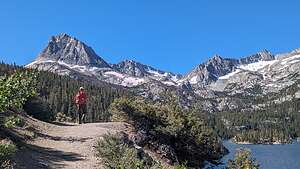 South Lake to Long Lake HikeIt was Friday, which means work day for Andrew and Celeste, so Herb and I decided to do the hike from South Lake to Long Lake, about a half hour drive from their place. We had done this hike back in 2019, and I had gotten terrible altitude sickness. This time I would make sure to drink lots of water along the way.
South Lake to Long Lake HikeIt was Friday, which means work day for Andrew and Celeste, so Herb and I decided to do the hike from South Lake to Long Lake, about a half hour drive from their place. We had done this hike back in 2019, and I had gotten terrible altitude sickness. This time I would make sure to drink lots of water along the way.
The nice thing about hiking in Bishop is that no matter how hot it is (it’s very hot in the summer), you can just drive for 20 to 30 minutes to higher elevations and pretty much dial in the temperature you want. This hike started at 9,750 feet, and we really weren’t acclimated yet.
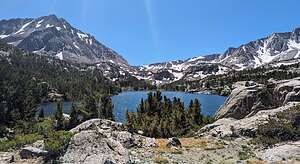 South Lake to Long Lake HikeThe trail to Long Lake starts at the end of South Lake Road (elevation (9,800) and climbs steadily uphill along the eastern shore of lovely South Lake. We continued climbing steadily up until after about 3 miles we reached Long Lake, another stunningly beautiful alpine lake at 10,760 elevation - so we had climbed over 1,000 feet already.
South Lake to Long Lake HikeThe trail to Long Lake starts at the end of South Lake Road (elevation (9,800) and climbs steadily uphill along the eastern shore of lovely South Lake. We continued climbing steadily up until after about 3 miles we reached Long Lake, another stunningly beautiful alpine lake at 10,760 elevation - so we had climbed over 1,000 feet already.
The mosquitoes were terrible at the lake, so I stopped to put mosquito repellent on my arms. I use Picaridin because it doesn’t have Deet. While it definitely worked on my arms, they started biting me right through my shirt, so I had to add more there. I was pretty much covered with bites.
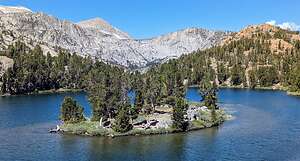 South Lake to Long Lake HikeAfter all that work going uphill, the way back was pretty much all downhill. In total, the hike was about 5 miles with a 1,036 elevation gain. But, it was pretty hard for us because it started at around 9,800 feet, and we were not acclimated yet. Still, the stopping to drink water every half hour definitely held off the altitude sickness I experienced the last time.
South Lake to Long Lake HikeAfter all that work going uphill, the way back was pretty much all downhill. In total, the hike was about 5 miles with a 1,036 elevation gain. But, it was pretty hard for us because it started at around 9,800 feet, and we were not acclimated yet. Still, the stopping to drink water every half hour definitely held off the altitude sickness I experienced the last time.
So no altitude sickness, but this time I had to worry about my mosquito bites, because today’s Inyo Register reported that mosquito pools in Bishop had tested positive for encephalitis and West Nile disease. Oh great.
Andrew and Celeste are terrific hosts, so they prepared dinner for us that night, as they would every night during our stay. What a great Airbnb
Day 2 - Ancient Bristlecones with the Rotary Club
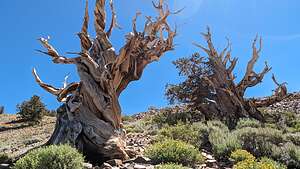 Ancient BristleconesIt was Saturday, so no work for the kids today. Andrew mentioned that their Rotary Club was having a field trip up to the Ancient Bristlecones and that a naturalist would lead us on a hike along the Discovery Trail.
Ancient BristleconesIt was Saturday, so no work for the kids today. Andrew mentioned that their Rotary Club was having a field trip up to the Ancient Bristlecones and that a naturalist would lead us on a hike along the Discovery Trail.
We had been to the Bristlecones before, but not that trail, and not with our own naturalist. So we happily climbed into Andrew’s car and drove down to Big Pine and then east on State Highway 168 up to the Schulman Grove Visitor Center where we would all be meeting.
 Twisted BristleconeIt was a great group of people and our naturalist guide was very fun and informative.
Twisted BristleconeIt was a great group of people and our naturalist guide was very fun and informative.
I already knew that bristlecone pines are the oldest known living trees, but along our 1-mile hike on the Discovery Trail, I learned a few new things from our naturalist guide.
The twisted and seemingly half-dead trunks associated with bristlecones are the result of a trait called sectored architecture. This means each tree root only feeds the part of the tree directly above it. So if a root dies, only the tree section that’s directly connected to that root dies. This trait allows the bristlecone to draw all available water and nutrients to a small percentage of the tree during drought periods. The dead, sculpted trunks are sections the trees let die to save itself in the long term. It is common at high elevations to see bristlecone pines with only one or two living sectors, defined by a strip of bark.
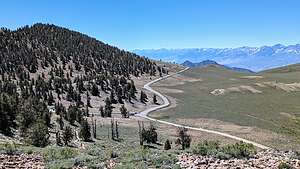 Bristlecone forest on dolomite soil hillThe Ancient Bristlecones also prefer rocky dolomite soils where most other types of vegetation cannot grow. This lack of vegetation helps reduce fire danger, as the isolated Bristlecone trees are often perched on rocky outcroppings with no surrounding surface fuels to catch on fire.
Bristlecone forest on dolomite soil hillThe Ancient Bristlecones also prefer rocky dolomite soils where most other types of vegetation cannot grow. This lack of vegetation helps reduce fire danger, as the isolated Bristlecone trees are often perched on rocky outcroppings with no surrounding surface fuels to catch on fire.
That's why only bristlecones grow on the dolomite hillside, while on the flatter clayier area below, there are no Bristlecones, but only grasses and other shrubs.
It was a very fun and educational day. Thank you Bishop Rotary Club!
Day 3 - Family hang-out day
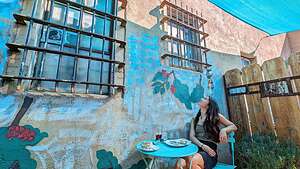 Bishop Coffee ChurchSunday morning in Bishop means Coffee Church, a secular gathering of friends, family, and neighbors at the Indy Roasting Company. In addition to Coffee Pour Overs and Mexican and Scandinavian Coffee Drinks, there are delicious home-made artisan pastries. We try to go there whenever we are in town.
Bishop Coffee ChurchSunday morning in Bishop means Coffee Church, a secular gathering of friends, family, and neighbors at the Indy Roasting Company. In addition to Coffee Pour Overs and Mexican and Scandinavian Coffee Drinks, there are delicious home-made artisan pastries. We try to go there whenever we are in town.
Afterwards it was father-son bonding time with some home maintenance. Herb and Andrew had a very productive day installing recessed lighting in their Family Room ceiling. Andrew has gotten so handy that Herb wants to enlist him to help do the same in our Family Room.
The event we were all looking forward to today, however, was dinner at the Mono Inn to partake in their highly rated 5-course Summer Tasting Menu. Mono Lake is about an hour drive north of Bishop on the highly scenic Highway 395, also known as the Eastern Sierra Scenic Byway.
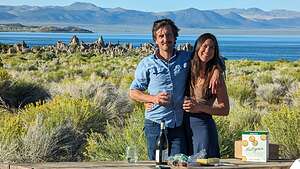 Pre-dinner cocktail hour at the South TufasWe went up a bit ahead of time to have pre-dinner wine and cheese at the South Tufa Reserve on the South side of the lake - a stunning setting, especially during sunset.
Pre-dinner cocktail hour at the South TufasWe went up a bit ahead of time to have pre-dinner wine and cheese at the South Tufa Reserve on the South side of the lake - a stunning setting, especially during sunset.
Then it was on to the historic Mono Inn. Originally established in 1922, the Historic Mono Inn has been a destination for hungry, weary travelers in the eastern Sierra Nevada for decades. Wow, and here we were, four hungry, weary travelers cruising up 395 looking for a good meal over 100 years later.
 Mono Inn ViewIn 1996, the inn was bought by the Ansel Adams family, who remodeled it into a beautiful gallery and restaurant. With its sweeping, majestic view of Mono Lake, it became a cornerstone of fine dining in the area.
Mono Inn ViewIn 1996, the inn was bought by the Ansel Adams family, who remodeled it into a beautiful gallery and restaurant. With its sweeping, majestic view of Mono Lake, it became a cornerstone of fine dining in the area.
In 2007, Sarah Adams (Ansel Adams’ granddaughter) closed the Inn and moved back to the coast. It changed hands a bit for the next 14 years, but has been under new ownership since May 2021. All I could find on the internet is that the new owner is named Hillary and the Chef is Jason Custer.
I had never been here before, but whatever they have done is incredible. The food is creative and delicious, the service is impeccable, and the views are amazing.
What a great experience!
Day 4 - Little Lakes to Gem Lake
 Little Lake to Gem Lakes hikeAnother day, another awesome hike, once again at a higher elevation than Bishop to escape the Bishop heat. It’s nice how you can pretty much dial in the temperature you want by just driving to a trailhead at a higher elevation.
Little Lake to Gem Lakes hikeAnother day, another awesome hike, once again at a higher elevation than Bishop to escape the Bishop heat. It’s nice how you can pretty much dial in the temperature you want by just driving to a trailhead at a higher elevation.
Today’s hike was to be a longer one - an 8-mile, out-and-back hike from the Rock Creek parking lot past several alpine lakes to Gem Lake, which is at an elevation of a little over 11,000 feet. That’s pretty high, so I would have to make sure that I stopped frequently to drink enough water to fend off the altitude sickness which I tend to be susceptible to.
 Little Lakes to Gem Lakes hikePlus, I proactively put on insect repellent after my mosquito experience on the Long Lake hike, especially after learning that mosquito pools around Bishop had recently tested positive for encephalitis.
Little Lakes to Gem Lakes hikePlus, I proactively put on insect repellent after my mosquito experience on the Long Lake hike, especially after learning that mosquito pools around Bishop had recently tested positive for encephalitis.
This is an extremely popular hike, so the parking lot was already full when we got there around 11:00 am - a bit late for hikers. We had to drive back down the road a half mile to another lot, adding 1 mile to our already long 8-mile hike.
From the real parking lot, we set out on a fairly flat trail that parallels Rock Creek, with nice mountain views along the way. There was also plenty of colorful lupine and Indian paintbrush to even further improve the scenery.
 Getting closer to Gem LakeWe passed several pretty alpine lakes along the way - Mack Lake, Marsh Lake, Heart Lake, Box Lake, and then Long Lake, where we stopped to eat our lunch. By now we had hiked about 2.5 miles and only climbed about 350 feet.
Getting closer to Gem LakeWe passed several pretty alpine lakes along the way - Mack Lake, Marsh Lake, Heart Lake, Box Lake, and then Long Lake, where we stopped to eat our lunch. By now we had hiked about 2.5 miles and only climbed about 350 feet.
After lunch we continued walking along Long Lake for about a half mile before beginning another ascent, probably the steepest part of the trail.
 Gem Lake at lastWe skipped the detour to Chickenfoot Lake and began ascending the main trail towards Morgan Pass and Gem Lakes. To get to Gem Lake, we had to cross a stream by balancing our way over a few logs and rocks that seemed to be placed to ensure an easy crossing.
Gem Lake at lastWe skipped the detour to Chickenfoot Lake and began ascending the main trail towards Morgan Pass and Gem Lakes. To get to Gem Lake, we had to cross a stream by balancing our way over a few logs and rocks that seemed to be placed to ensure an easy crossing.
After a bit more ascent, we passed several of the gem lakes before arriving at the final and largest of the Gem Lakes, situated in a bowl below sheer granite faces and steep boulder fields. The water was a brilliant turquoise blue.
It was so beautiful that we hung out there for a bit before heading back. All in all, it was 9 miles with 1,122 feet of elevation gain, which isn’t much for that distance.
Then it was back to Bishop for another great dinner and evening with Andrew and Celeste.
Day 5 - Convict Lake chill day
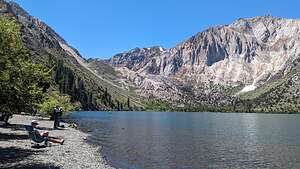 Chilling at Convict LakeWe briefly considered doing a 10-mile, 3,000-foot elevation gain hike to the Big Pine Lakes today, but then reconsidered and instead decided to bring our kindles and relax and read beside beautiful Convict Lake, another one of the Eastern Sierra gems.
Chilling at Convict LakeWe briefly considered doing a 10-mile, 3,000-foot elevation gain hike to the Big Pine Lakes today, but then reconsidered and instead decided to bring our kindles and relax and read beside beautiful Convict Lake, another one of the Eastern Sierra gems.
Unlike the other stunning alpine lakes we had hiked to this week, this one can be driven right up to. The distance from our car to the lake was probably 20 yards. Perfect!
Carved out by glaciers, this beautiful oblong-shaped lake is filled with turquoise-blue water as clear as glass, and surrounded by a box canyon set in the mountains. Mount Morrison, the tallest mountain in the area at 12,241 feet, rises above the southeast end of the lake.
 Convict LakeThe lake is known for its great trout fishing, but I couldn’t get Herb to trade his kindle for a fishing rod.
Convict LakeThe lake is known for its great trout fishing, but I couldn’t get Herb to trade his kindle for a fishing rod.
There is an interesting story behind how Convict Lake got its name. Way back in 1871, a group of convicts escaped from a prison in Carson City, Nevada, and took refuge near the lake, which was then called Monte Diablo. They were pursued by a posse and a shootout began, killing a number of both posse members and convicts. The large peaks above the lake were renamed after the fallen posse members and the lake itself became known as Convict.
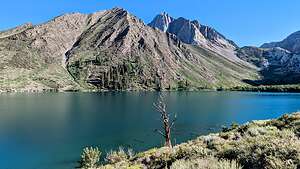 Convict LakeWe spent a very pleasant few hours reading our books, occasionally looking up to take in the scenery and watch the pontoon boats leisurely cruise along the lake.
Convict LakeWe spent a very pleasant few hours reading our books, occasionally looking up to take in the scenery and watch the pontoon boats leisurely cruise along the lake.
At 4:00, we decided it was time to move our bodies a bit, so we took the lovely 3-mile stroll around the perimeter of the lake. About halfway around, we had to take off our shoes to cross the Convict Creek inlet, which covered a good 30 feet or so of the trail.
So, it was another great day in the Eastern Sierra.
Tomorrow we would head back home to Sonoma Valley. There was so much variety along this trip that it felt like we had been away for a month.
Virginia City
Thursday, August 24, 2023 - 9:00am by Lolo30 miles and 0.75 hours from our last stop
Travelogue
 Virginia CityOn our way to Bishop, we decided to take a slight detour to go through Virginia City, a place I have always been interested in visiting. In fact, if I knew how cool it was, I would have suggested driving an extra half hour last night, rather than staying in Reno. It would have been much more fun to eat in a saloon and stay in an old period house.
Virginia CityOn our way to Bishop, we decided to take a slight detour to go through Virginia City, a place I have always been interested in visiting. In fact, if I knew how cool it was, I would have suggested driving an extra half hour last night, rather than staying in Reno. It would have been much more fun to eat in a saloon and stay in an old period house.
But at least we were here now, so I intended to enjoy it. Since we moved out West, we’ve been to many ghost towns and mining sites. Virginia City is not by any means a ghost town, but rather a boom and bust town that rediscovered itself as a valuable, tastefully done, tourist attraction.
But first, a little bit of its history...
 Virginia CityIn 1859, just a decade after the California Gold Rush, an incredible amount of silver was discovered along the eastern slope of Mt. Davidson near Virginia City. Named the Comstock Lode, after Henry Comstock, the part-owner of the property it was discovered on, was one of the most important mining discoveries in American History and virtually ended the California Gold Rush.
Virginia CityIn 1859, just a decade after the California Gold Rush, an incredible amount of silver was discovered along the eastern slope of Mt. Davidson near Virginia City. Named the Comstock Lode, after Henry Comstock, the part-owner of the property it was discovered on, was one of the most important mining discoveries in American History and virtually ended the California Gold Rush.
This was the first major silver strike in the U.S. and one of the richest in the country's history. From 1860 to 1889 , almost seven million tons of ore were extracted and milled, producing what today would equal approximately $700 million in profits.
This wealth came to the attention of President Lincoln and was used to help finance the Union war effort to defeat the southern states during the Civil War.
 Virginia CityThe population of Virginia City and nearby Gold Hill grew from 4,000 in 1862 to a thriving metropolis of 25,000 residents in 1874. In the 1870s, Virginia City was one of the most important cities between Chicago and the West Coast, and even rivaled San Francisco. At its peak it had 25 theaters, over 100 saloons, five police precincts, a lively red-light district, and multiple newspapers. One of those newspapers, the Territorial Enterprise, hired a young reporter named Samuel Clemens. It was while working in Virginia City that he first called himself Mark Twain.
Virginia CityThe population of Virginia City and nearby Gold Hill grew from 4,000 in 1862 to a thriving metropolis of 25,000 residents in 1874. In the 1870s, Virginia City was one of the most important cities between Chicago and the West Coast, and even rivaled San Francisco. At its peak it had 25 theaters, over 100 saloons, five police precincts, a lively red-light district, and multiple newspapers. One of those newspapers, the Territorial Enterprise, hired a young reporter named Samuel Clemens. It was while working in Virginia City that he first called himself Mark Twain.
 Virginia CityAs happens with most boomtowns, bust followed boom, and by 1881, the Comstock Lode was exhausted. Then the next shiny object (literally) was discovered in Bodie, CA (which we have also visited), and thousands of people in the District began to leave for better opportunities there and elsewhere.
Virginia CityAs happens with most boomtowns, bust followed boom, and by 1881, the Comstock Lode was exhausted. Then the next shiny object (literally) was discovered in Bodie, CA (which we have also visited), and thousands of people in the District began to leave for better opportunities there and elsewhere.
Virginia City’s population shrank to a few hundred people, who, fortunately for us, became the custodians for hundreds of 19th-century buildings, abandoned mine shafts and tunnels and countless documents and photographs pertaining to the Comstock District's boom period.
Today, the Virginia City Historic District is a remarkable collection of over 400 buildings – most dating from the 19th-century and abandoned mine shafts, and still retains the feel of a 19th century western mining town.
 Out beautiful ammoniteI love history and had totally absorbed myself in Colonial American history when we lived on the East Coast. Now, I am very much enjoying learning the very different history of the settlement and growth of the West.
Out beautiful ammoniteI love history and had totally absorbed myself in Colonial American history when we lived on the East Coast. Now, I am very much enjoying learning the very different history of the settlement and growth of the West.
On the main drag, we were attracted to the window display of rocks and minerals in the front window of a store right on the main drag called Stone Age Quarry. In particular, we were both drawn to a beautiful pair of spiral shells, sort of like a nautilus, but more colorful.
 My sensitive cowboyNow, Herb and I are not big shoppers, so it was a bit surprising to both of us that we went inside to inquire about what it was. The very friendly and informative owner of the store said that the pair were the shells from an organism called an Ammonite, which died out about 66 million years ago. Fossils of them are found all around the world. This particular pair came from Madagascar.
My sensitive cowboyNow, Herb and I are not big shoppers, so it was a bit surprising to both of us that we went inside to inquire about what it was. The very friendly and informative owner of the store said that the pair were the shells from an organism called an Ammonite, which died out about 66 million years ago. Fossils of them are found all around the world. This particular pair came from Madagascar.
The lines on the shell are called “sutured patterns” and they became increasingly complex as the organism evolved. They were absolutely beautiful.
$48 for the pair seemed reasonable, so the pair is now proudly displayed in my bookcase.
Oh, and kudos to Herb for being brave enough to strut past the saloons on Main Street with his very colorful rock climbing shorts and Chaco sandals, rather than jeans and cowboy boots, clutching our beautiful ammonite.
Reno
Wednesday, August 23, 2023 - 1:45pm by Lolo427 miles and 7.5 hours from our last stop - 1 night stay
Travelogue
 Reno skylineI’m not a big Reno fan, but we had already driven over 7 hours and it had the most options. Ignoring our son’s advice that the River District was a bit sketchy, we booked a room at the Plaza Resort Club Hotel, right near the river.
Reno skylineI’m not a big Reno fan, but we had already driven over 7 hours and it had the most options. Ignoring our son’s advice that the River District was a bit sketchy, we booked a room at the Plaza Resort Club Hotel, right near the river.
We also picked it for two other reasons: it did not have a casino, and it had a free self-parking, parking garage.
That parking garage turned out to be a bit of a problem because we barely got in because our roof rack was just about scraping the top of the garage.
However, the room was very nice and had a great view of the city, but our son was right, the neighborhood was a bit sketchy with homeless people, and one in particular having quite an argument with himself.
We needed to eat something, so we walked to the Pizza Collective, not too far from our hotel. Instead of eating it there, we got it to go, because our room had a really large table, right near the window overlooking the city.
The pizza was good, the bed was comfortable, and the price was right. That’s all we needed.
Eugene
Tuesday, August 22, 2023 - 10:30am by Lolo225 miles and 3.5 hours from our last stop - 1 night stay
Travelogue
 Campbell House InnAs I mentioned in the previous post, even on long-driving days, we like to find something to look forward to at the end of the day. Originally it was supposed to be the Bend area of Oregon, but the air quality was just too awful to make that any fun.
Campbell House InnAs I mentioned in the previous post, even on long-driving days, we like to find something to look forward to at the end of the day. Originally it was supposed to be the Bend area of Oregon, but the air quality was just too awful to make that any fun.
So, as Herb drove, I played on my phone looking for something that would be fun and that we could arrive at no later than 6 pm to have time to enjoy.
Then there it was - the lovely historic Campbell House Inn in Eugene, Oregon, a lovely historic B&B and a cool town that we had never been to before.
 Campbell House GazeboThe Inn did not disappoint. The Inn, which was originally a home built in 1892, had been fully restored as a luxurious boutique hotel. It was situated on an acre of beautifully landscaped grounds, right in the historic district of Eugene. I couldn’t understand why it was only $140 per night (including a sumptuous breakfast), when our crappy little hotel room in Port Angeles cost over $200. Apparently that still annoys me.
Campbell House GazeboThe Inn did not disappoint. The Inn, which was originally a home built in 1892, had been fully restored as a luxurious boutique hotel. It was situated on an acre of beautifully landscaped grounds, right in the historic district of Eugene. I couldn’t understand why it was only $140 per night (including a sumptuous breakfast), when our crappy little hotel room in Port Angeles cost over $200. Apparently that still annoys me.
Each of the rooms were named after a Campbell family member. We were staying in the “Alfred,” which for some reason cracked us up.
Anyway, we started our evening with a glass of wine in the gazebo in the garden. We were having such a nice time that we almost forgot about dinner. Not wanting to go anywhere at that point, we ate some Pad Thai Salad that we had bought in a Ucluelet supermarket.
Then I gave our private bathtub jacuzzi a whirl and almost overflowed the bubbles from my relaxing bubble bath.
 5th Street MarketThe next morning we figured we should explore Eugene before moving on.
5th Street MarketThe next morning we figured we should explore Eugene before moving on.
But first the complimentary breakfast in the Inn’s lovely dining room, which included eggs, sausage, veggies, and freshly baked scones. The setting and the food were wonderful.
After breakfast we headed over to nearby Alton Baker Park to walk along the Prefontaine Trail. Anyone with a son that ran track in high school or college knows of Steve Prefontaine, the legendary track star at the University of Oregon in the 1970s. Sadly, he tragically died in a car accident in 1975 when he was only 24 years old and at the height of his running career.
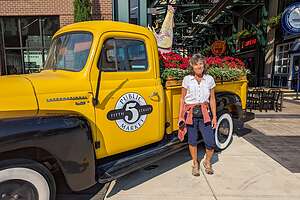 Lolo at the 5th Street MarketThe night before every track meet in high school, our sons and a few of their teammates would gather to eat pasta and watch the Prefontaine movie. They must have seen it a hundred times.
Lolo at the 5th Street MarketThe night before every track meet in high school, our sons and a few of their teammates would gather to eat pasta and watch the Prefontaine movie. They must have seen it a hundred times.
After his untimely death, the city of Eugene built the Prefontaine Trail in nearby Alton Baker Park. In 2019 it was designated a city history landmark. Of course, we had to walk along it. We would have more appropriately run if it hadn’t been for that gigantic breakfast at the Campbell House Inn.
Our next stop was the 5th Street PublicMarket, the area’s premier open-air shopping destination with up-scale stores, restaurants, bars, tasting rooms, and cafes. It was quite a lively place.
Ok, time to continue on to Bishop, probably finding another place to stop along the way.
Description
44.05708144665744, -123.0900370075083
Hurricane Ridge (Olympic National Park)
Tuesday, August 22, 2023 - 8:30am by Lolo170 miles and 4 hours from our last stop - 1 night stay
Travelogue
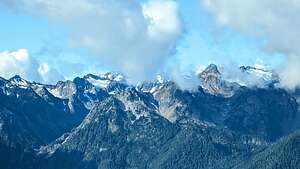 Hurricane Hill TrailWe woke up in our Port Angeles motel to bright sunshine, which meant we would finally be able to do the Hurricane Hill hike in nearby Olympic National Park. We had been thwarted twice already - once two years ago when the weather was awful, and our way up the coast a week ago when the Hurricane Ridge Road was closed for tree removal.
Hurricane Hill TrailWe woke up in our Port Angeles motel to bright sunshine, which meant we would finally be able to do the Hurricane Hill hike in nearby Olympic National Park. We had been thwarted twice already - once two years ago when the weather was awful, and our way up the coast a week ago when the Hurricane Ridge Road was closed for tree removal.
The Hurricane Hill trail starts at the end of Hurricane Ridge Road. Even though we got there early, the parking lot was full, so we drove a short distance back to the overflow parking.
From there we walked on a past through the woods to the actual trailhead. The trail is paved and quite easy, but it did lead us through a beautiful subalpine meadow with spectacular views of the glacier-covered Olympic Mountains and the Strait of Juan de Fuca.
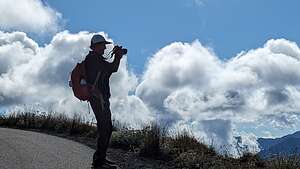 Hurricane Hill TrailThe trail is 3.2 miles out-and-back (with 800 foot elevation gain), but we managed to do over 4 because we were running around so much at the top enjoying all the views.
Hurricane Hill TrailThe trail is 3.2 miles out-and-back (with 800 foot elevation gain), but we managed to do over 4 because we were running around so much at the top enjoying all the views.
Okay, now that we checked off this hike, I think we have pretty much seen and done all of Olympic National Park.
Actually, there was something we hadn’t done - the section of the Olympic Loop Scenic Drive from Port Townsend to Olympia. It was a beautiful drive, tracing the shores of the Hood Canal for a good part of it. Unfortunately, Herb slept through most of it, as he likes to do when I take over the wheel.
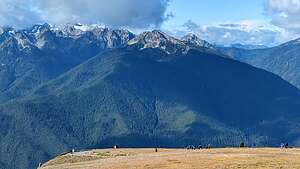 Hurricane Hill TrailNow it was time to head south towards Bishop, California where our son and daughter-in-law live. It wasn’t exactly on the way home, but we missed them, and Bishop is such a beautiful place that we pointeds the car in that direction. Google Maps told us it would take 16 hours to get there, so we started thinking about places to stop along the way.
Hurricane Hill TrailNow it was time to head south towards Bishop, California where our son and daughter-in-law live. It wasn’t exactly on the way home, but we missed them, and Bishop is such a beautiful place that we pointeds the car in that direction. Google Maps told us it would take 16 hours to get there, so we started thinking about places to stop along the way.
Originally we were hoping to spend some time in the Bend, Oregon area, but the smoke was so bad that Oregon was going to pretty much be a drive-through state this time.
So our plan was to just keep driving until we felt like stopping, hopefully some place that would be fun in some way. We didn't want to go much more than 4 hours.
Then I found the Campbell House Inn in Eugene, Oregon, a highly-rated B&B with a lovely garden with gazebos and adirondack chairs to sit in. Oh, and a jacuzzi in the bathroom. Sounded perfect!
Description
47.93314492065909, -123.40964663498389
